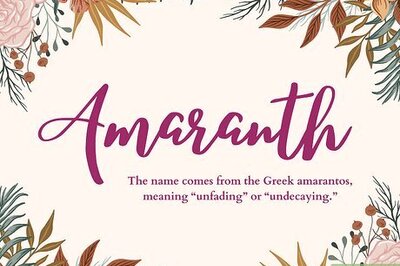
views
Nationalism was very much a part of Bollywood consciousness when India fought wars against hostile neighbours in 1948, 1962, 1965 and 1971.
When war broke out with Pakistan in 1948, Russi Karanjia, a close friend of Prime Minister Jawaharlal Nehru and editor of the news magazine Blitz, teamed up with Bollywood to provide relief and succour to the civilian population of Kashmir battling a surprise invasion that was barbaric in nature.
The big question he had to tackle at the time was whether film stars, self-centred and egoistic for the most part and preoccupied with their films, would set time aside to participate in ‘A nite with stars’.
Raj Kapoor, Nargis, Kamini Kaushal, Geeta Bali, Sitara Devi, Agha Jan Baig, IS Johar, Kishore Sahu, Mukesh and several others agreed to do so without hesitation. Sitara Devi gave a Kathak performance, while Kamini Kaushal danced the Bharatanatyam and Mukesh sang.
Framroze Sidhwa, then proprietor of Regal Cinema, New Delhi, offered the premises free of charge for holding the event. The Indian Peoples Theatre Association provided lights, curtains, stagehands and so on.
Filmmakers and actors of that era mined these events for their inherent dramatic potential and catered to the country’s patriotic sentiments by adapting them for the silver screen.
The most memorable film on India’s wars was 1964’s Haqeeqat, made with government assistance just two years after the war with China. It was essentially a dramatized account of the heroic resistance put up by the Indian Army against invading Chinese troops in the Ladakh region.
According to journalist-writer Sandeep Unnithan, it was the first full-length depiction of war in Indian cinema. Writing in India Today to mark the fiftieth anniversary of the Indo–China conflict in 2012, Unnithan observed, “For most Indians who even remember India and China went to war a half-century ago, the only movie reference is Haqeeqat, a black and white Hindi film made by Chetan Anand in 1964.”
The movie portrayed actor Balraj Sahni as the major of a company facing Chinese aggression: in one memorable scene, he sardonically chews on a cigarette as he watches a Chinese soldier mouthing ‘Hindi Chini bhai bhai’
That cinema and the workings of the nation came together, especially in times of strife, was evident in the efforts of Sunil and Nargis Dutt, who toured war-torn zones to entertain jawans during the 1962 Indo–China conflict.
The idea came to them when the Dutts had presented Prime Minister Jawaharlal Nehru with a cheque of one lakh rupees for the National Defence Fund, prompting the then PM to mention the many jawans who were living in harsh conditions, far from home, with no radios.
Sunil Dutt proposed trips to the area to boost the soldiers’ morale and Nehru happily agreed with the idea. Dutt also requested fellow artistes, like Lata Mangeshkar, Kishore Kumar and Waheeda Rahman, to do the same.
In 1963, as part of the Republic Day celebrations in Delhi, singer Lata Mangeshkar performed in front of an audience that comprised President S Radhakrishnan, Prime Minister Nehru, Indira Gandhi and many distinguished guests. Opening with the bhajan ‘Allah tero naam’ on Dilip Kumar’s request, she had followed it up with ‘Ae mere watan ke logon’.
Later, the singer reportedly confessed to journalist Subhash K Jha, ‘I was much relieved to get it over with. After I finished my two songs, I went backstage to relax with a cup of coffee, unaware [of] what an enduring impact the song had created. Suddenly, I heard Mehboob Khan Saab calling for me. He caught hold of my hand and said, “Chalo, Panditji ne bulaya hai [Come on, Panditji has sent for you]”.
I wondered why he wanted to see me. When I went out, everyone, including Panditji, his daughter Indiraji, Radhakrishnanji stood up courteously to greet me. Mehboob Khan Saab said, “Yeh rehi hamari Lata. Aapko kaisa laga uska gaana [This is our Lata. How did you like her performance]?” Panditji said, “Bahut achcha. Mere aankhon mein paani aa gaya [Wonderful! She moved me to tears].”’
The singer was subsequently invited by Nehru for tea at Teen Murti Bhavan, the Prime Minister’s residence in New Delhi at the time. Recalling the occasion, Lata said, “While the rest of the entourage spoke eagerly with Panditji, I stood in a dark corner, hesitant to make my presence felt. Suddenly, I heard Panditji say, ‘Lata kahaan hai [Where is Lata]?’ I kept standing where I was. Then Mrs Indira Gandhi came and took my hands saying, ‘I want you to meet two of your little fans.’ She introduced me to little Rajiv and Sanjay Gandhi. They did namaste and ran away.”
“Then Panditji again asked for me. Mehboob Khan Saab came and took me to Panditji. Panditji asked, ‘Are you going to go back to Mumbai and sing ‘Ae mere watan ke logon?’ I replied, ‘No, it was meant to be a one-off thing.’ He wanted a picture with me. We posed for a keepsake and then I quietly left. I had to rush back because it was my sister Meena’s wedding in Kolhapur. When I returned to Mumbai the next day with my friend Nalini, I had no idea that the song had already become a rage. When we reached Mumbai, the city and the media were buzzing with the impact that the song had made in Delhi, how Panditji broke down, etc, etc.”
Nehru’s daughter Indira, who would become the country’s PM in 1966, continued to encourage the Dutts in these efforts. During the 1971 Indo–Pakistan war that led to the creation of Bangladesh, actress Waheeda Rehman, along with her colleagues Pran and Shammi Kapoor, formed the Bangladesh Sahayak Samiti of Maharashtra with the express purpose of collecting funds with their cultural
troupes. The group also included Sunil Dutt, Nargis, Lata Mangeshkar, Kalyanji–Anandji and many others.
In December 2012, when Bangladesh honoured Anandji in Dhaka, he reminded its Prime Minister Sheikh Hasina of the time when women attending music concerts organized in aid of Bangladesh would remove the gold ornaments they were wearing and hand them over with a smile as their contribution to the cause. Anandji was part of the cultural troupe that had raised funds for Bangladesh Liberation war.
Rasheed Kidwai is a visiting Fellow with the Observer Research Foundation (ORF). His book, 'Neta Abhineta –Bollywood Star Power in Indian Politics' (Hachette) tracks Hindi cinema personalities who dabbled in politics and made to the Parliament.


















Comments
0 comment